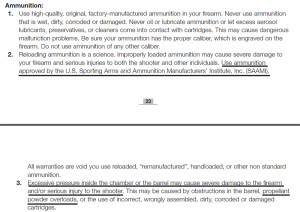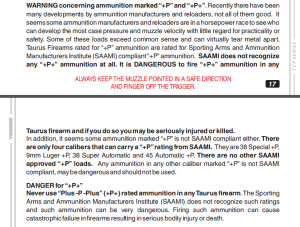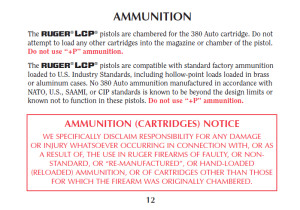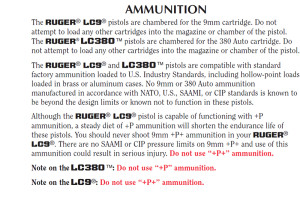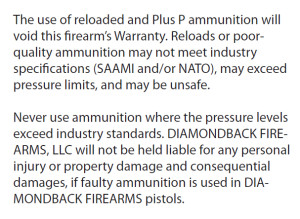In my ongoing series of testing .380 ACP ammo from micro-pistols, I’ve been repeatedly asked to test some of the so-called “+P” loadings. Various manufacturers including Buffalo Bore, Magsafe, Underwood and others offer .380 ACP ammo in a “+P” version. And now, with the 9mm Ammo Quest, I’m starting to get requests to test “+P+” ammo. People want these types of rounds tested, which I can understand, but I’d like to explain the reasons why I think it’s a bad idea.
What is +P anyway?
There’s a standards-setting organization known as the Sporting Arms and Ammunition Manufacturer’s Institute (SAAMI). SAAMI’s been around since 1926, and they establish and publish the standards for ammunition that the gun manufacturers then use to design their guns around. SAAMI specifies pressure levels that ammo is allowed to obtain, for any given caliber. For example, for .40 S&W, SAAMI specifies a maximum average pressure of 35,000 PSI. For .44 Special, they specify a maximum average pressure of 15,500 PSI.
But for a few rounds, they specify a second listing — a listing for “+P”. These are higher-pressure rounds and are listed separately, as a different caliber. You can think of them as “+pressure”, as they are all higher-pressure variants of an existing cartridge. There are four cartridges for which SAAMI has created “+P” categories: .38 Special, .38 Super Automatic, 9mm Luger, and .45 ACP. That’s it. There is no such thing as “.45 Colt +P” or “.380 ACP +P” in the SAAMI standards. There is no general understanding that “overloading ammo makes it +P”; instead “+P” has a very specific, very defined meaning — it is a separate category for specific cartridges. The differences are relatively mild, in that the +P variants are around 9 to 17% higher pressure than their “parent” cartridges:
Pressure: Regular +P
.38 Special 17,000 PSI 20,000 PSI
9mm Luger 35,000 PSI 38,500 PSI
.45 ACP 21,000 PSI 23,000 PSI
What About .380 ACP +P?
There isn’t one. There is no standard, as specified by SAAMI, for .380 ACP +P. It simply doesn’t exist. ANY ammo, claiming to be .380 ACP +P, is, by very definition, nonstandard. We don’t know how high the pressure levels may be. The only thing we do know, is that the pressure levels are almost certainly higher than what SAAMI has established as the standard.
What About +P+?
Same thing. There is no SAAMI standard for any caliber of ammo classified as +P+. And therefore any ammo claiming to be +P+ is, by very definition, nonstandard.
So — Wait — What?
Think of it like this — the Motion Picture Association of America (MPAA) establishes movie ratings of G, PG, PG-13, R, and NC-17. Those are the existing, standard ratings. Those are all the ratings. So what would it mean if someone released a move rated “PG-15”? Well, in terms of the existing ratings, it wouldn’t mean anything — it’d mean they basically made up their own rating, right? And what standards would it be held to? Certainly not the MPAA’s.
Same thing with ammo — the labels and standards are established, and the organization that establishes those standards has been around since 1926. So if some ammo manufacturer makes ammo that doesn’t comply with those standards… what should they call it? Apparently, ammo manufacturers have taken to making up their own names — such as .380 ACP +P, .45 Colt +P, and 9mm +P+. None of those are SAAMI standards.
So Is It Dangerous?
The gun manufacturers certainly seem to think so. If you read the owner’s manuals for their guns, as I’ve tried to do, I’ve never found a .380 pistol manufacturer that has said “it’s okay to use .380 ACP +P in this gun.” (edit: except for Kahr and now Beretta! See below.) And I’ve never found a 9mm pistol manufacturer that has said “it’s okay to use +P+ ammo in this gun”, including Kahr (edit: except for HK! See below.). Now, obviously I haven’t been able to check every pistol ever manufactured, so I guess it’s possible that there may be some special case out there (such as the Ruger Blackhawk being able to handle unusually powerful .45 Colt loads) but in general, the trend is very consistent and very clear — the manufacturers of the guns simply do not want you to use .380 ACP +P or any +P+ ammo in their guns. Here are a few example extracts from various pistol owner’s manuals:
But Buffalo Bore Says It’s Okay!
True, Buffalo Bore does have an FAQ answer on their site that says that they believe their .380 ACP “+P” ammo is safe for use in a Ruger LCP. Buffalo Bore acknowledges that there is no SAAMI standard for .380 ACP +P, but they say (paraphrased) “we’ve tried it and it works and we’ve never heard of any problems.” They acknowledge that the gun manufacturers warn against using non-SAAMI-spec ammo, and they attribute the manufacturer’s warnings against it as fear of lawsuits, rather than any inherent safety issue.
Is this true? Possibly. Or maybe not. Maybe it’ll cause a problem, maybe it won’t. But I’ve never been swayed by the argument that “we’ve tried it and haven’t heard of a problem” — because I’ve crossed the street many times and never been hit by a car, but I would never assert that “people don’t get hit by cars when crossing the street” because clearly they do. So the question is: who do you believe? The ammo company that’s trying to sell you ammo, thus assuring you it’s safe? Or the manufacturer of the pistol (who designed the pistol to be in accordance with SAAMI standards)? It doesn’t matter to me which one you choose, I’m just telling you why *I* won’t test or use it.
But… Isn’t .380 Deliberately Underloaded And I’ve Heard That .380 +P Is Really SAAMI-Compliant…
Okay, I’ve been asked this one multiple times — the thinking goes that in the 1970’s the ammo companies all decided voluntarily to just reduce the power of their ammo (for fear of lawsuits or for whatever reason), and as such no factory ammo really performs to the actual SAAMI specs. And, the people who advance this theory state that the so-called .380 ACP +P is really just loaded back up to the original standards, so it’s not really nonstandard at all.
Only — that’s just not true, at least according to Buffalo Bore. I wrote to Buffalo Bore, explained the theory going around, and asked them this specific question: “does your .380 ACP +P ammo exceed the 21,500 maximum pressure levels established by SAAMI?” I received a prompt response which says, and I quote:
YEs our +P 380 auto loads all exceed SAAMI specs. Whomever told you otherwise is misinformed.
That is exactly what I would have expected; they are using the terminology “+P” to inform the customer that their ammo is indeed not compliant within the SAAMI specs. They assert that it is still safe to use; I leave that to you to determine, but as always I want to provide the facts so that you can make your decision based on actual information, not hearsay and internet rumor.
Summary
Here’s the way I look at it — the manufacturers warn against using it. There is a standards organization that sets standards, and according to them there is no such standard for +P+ or .380 ACP +P. It may or may not be dangerous. It will certainly shorten the life of your firearm.
As a tester of self-defense/personal protection ammo, I don’t think it’d be responsible to use or recommend nonstandard ammo for such purposes. If there’s one absolute, overriding, unimpeachably important factor with self defense ammo, it is this: it absolutely MUST WORK when you need it to. To me, all other factors are subservient to this. As such, I cannot recommend using nonstandard ammo that the manufacturers expressly warn against.
Furthermore, I have a problem with the whole concept of using overpowered ammo in a defensive pistol. If you’re acknowledging that a given pistol and ammo platform is incapable of delivering the results you want, then you have two choices:
- Use hopped-up, nonstandard ammo to try to get better performance, or
- Just use a more powerful pistol.
To me, the right answer is simple and obvious (if expensive) — upgrade to a better-performing cartridge. If you can’t get what you need out of a .380, then it’s time to move to a .38 Special +P or to a 9mm. To me the answer is never going to be “just run nonstandard ammo in the underpowered pistol”; I think that’s just adding uncertainty (and, according to the pistol manufacturers, potential danger of failure or even injury) to the mix. And even if there is no failure in the pistol, you’ve almost certainly voided your warranty by using .380 ACP +P or any flavor of +P+. Is it worth it? Not to me… I say just get the more-powerful pistol and use the right tool for the job.
You don’t have to agree with me. You’re free to make your choices based on whatever criteria you want. I’m just laying out why I won’t use it, or test it, or endorse it for usage.
Edit 3/18/2014: In response to a reader comment saying that Kahr rates their P380 to “+P”, I called Kahr technical support for clarification. The technical support guy I spoke to sounded knowledgeable (i.e., he wasn’t just reading a printed statement, I spoke to him at length and he was able to explain reasons for his statements). He said that all Kahr firearms are rated for +P except for .40 S&W. I asked specifically about how they could rate a .380 for “+P” when no such standard exists from SAAMI, and was told that they consider “+P” to be between 17% to 30% higher pressure. They consider anything above 30% higher pressure to be “+P+” and they don’t warrant their pistols for “+P+”. I don’t know how they can make this statement about .380 ACP +P, since there is no standards body out there asserting that the pressures will be kept to less than 30% over standard, but — that’s what Kahr said. So if you want to use .380 ACP +P, apparently it’s okay to do so in a Kahr P380.
Edit 4/26/2014: Another reader has written in to show that the Kel-Tec P-3AT’s user manual sends a mixed message about .380 +P. The manual says “The P-3AT Pistol is designed and chambered for the .380 Auto cartridge. Do not use any other ammunition. The P-3AT will accept +P ammunition, however, not with continuous use.” That sure sounds like it’s saying that .380 +P is okay. However, a couple of paragraphs down, it also says “Never use ammunition where the pressure levels exceed industry standards.” Which, of course, is the very definition of .380 +P — the organization that sets the standards, has not set any standard for “.380 +P”, only for .380 ACP, and therefore any ammo exceeding .380 ACP pressure would, by this paragraph, be ruled out of consideration. So, it’s a mixed message. But I think the proper interpretation is that occasional, infrequent use of .380 +P is considered okay for the Kel-Tec P-3AT. Still seems curious as to how they can authorize the use of ammo that doesn’t comply to any existing written and codified standard, but — hey, at least there’s another option for those who do want to use that type of ammo.
Edit 3/25/2015: The Beretta Pico .380 pistol owner’s manual says that it is rated to handle .380 +P. The Pico has an unusual design with a very heavy barrel and two recoil springs, which make it able to absorb the additional energy from the .380+P rounds. Also, a reader wrote in to point out that HK pistols state in their operating manuals that they are approved for the use of +P and +P+ ammo, although with the usual statement that using such ammo will shorten the life of the firearm. I verified this by looking at the owner’s manual of the HK USP series (I don’t know what all HK pistols are listed as approving the use of +P+, but I can say that the HK USP definitely is). As of now I still haven’t heard of any other manufacturer authorizing the use of +P+ in their firearms.

